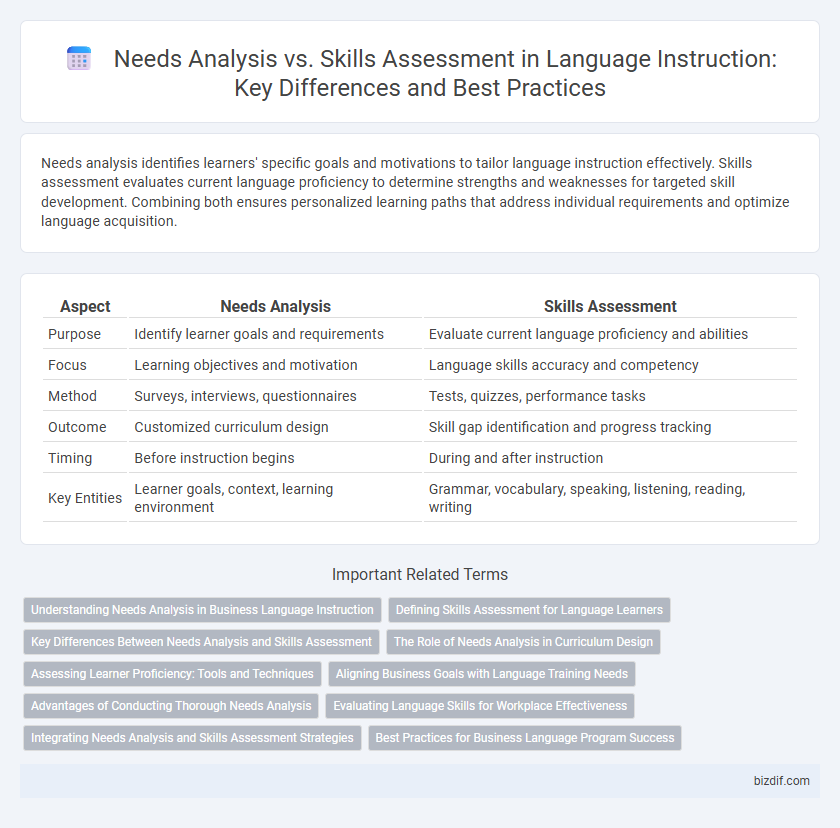Needs analysis identifies learners' specific goals and motivations to tailor language instruction effectively. Skills assessment evaluates current language proficiency to determine strengths and weaknesses for targeted skill development. Combining both ensures personalized learning paths that address individual requirements and optimize language acquisition.
Table of Comparison
| Aspect | Needs Analysis | Skills Assessment |
|---|---|---|
| Purpose | Identify learner goals and requirements | Evaluate current language proficiency and abilities |
| Focus | Learning objectives and motivation | Language skills accuracy and competency |
| Method | Surveys, interviews, questionnaires | Tests, quizzes, performance tasks |
| Outcome | Customized curriculum design | Skill gap identification and progress tracking |
| Timing | Before instruction begins | During and after instruction |
| Key Entities | Learner goals, context, learning environment | Grammar, vocabulary, speaking, listening, reading, writing |
Understanding Needs Analysis in Business Language Instruction
Needs analysis in business language instruction identifies employees' specific communication gaps by evaluating job roles, tasks, and workplace contexts to tailor language training effectively. This process gathers qualitative and quantitative data through surveys, interviews, and observations to align language objectives with organizational goals. Understanding needs analysis ensures targeted skill development, maximizing training relevance and improving employees' practical language performance in business settings.
Defining Skills Assessment for Language Learners
Skills assessment for language learners involves systematically evaluating specific language abilities such as listening, speaking, reading, and writing to identify proficiency levels and learning gaps. This targeted evaluation helps educators tailor instruction to address individual learner strengths and weaknesses, ensuring effective skill development. Defining skills assessment precisely supports accurate measurement and customized intervention in language education programs.
Key Differences Between Needs Analysis and Skills Assessment
Needs analysis identifies learners' language goals and contextual requirements to tailor instruction, while skills assessment measures actual language proficiency and performance levels. Needs analysis emphasizes understanding learners' motivations, desired outcomes, and situational factors, whereas skills assessment focuses on evaluating specific language abilities such as reading, writing, listening, and speaking. Effective language instruction requires integrating insights from both to design targeted curricula that address both learner aspirations and current competencies.
The Role of Needs Analysis in Curriculum Design
Needs analysis serves as a critical foundation in curriculum design by identifying learners' specific goals, motivations, and contextual requirements. It enables educators to tailor content, methodologies, and assessments to align with the target audience's language use scenarios. This targeted approach enhances the effectiveness and relevance of instructional programs, ensuring that learning outcomes meet real-world communicative demands.
Assessing Learner Proficiency: Tools and Techniques
Assessing learner proficiency involves utilizing a combination of diagnostic tests, standardized language proficiency exams, and performance-based evaluations to accurately gauge individual language skills. Tools such as the Common European Framework of Reference for Languages (CEFR) scales and oral interviews effectively measure listening, speaking, reading, and writing abilities. Techniques including self-assessment questionnaires and portfolio reviews provide qualitative insights that complement quantitative test results for a comprehensive proficiency profile.
Aligning Business Goals with Language Training Needs
Needs analysis identifies specific communication challenges and industry jargon relevant to employees' roles, ensuring language training targets practical workplace demands. Skills assessment measures current proficiency levels to customize learning paths, maximizing efficiency in addressing gaps tied to business objectives. Aligning these processes bridges organizational goals with tailored language development, enhancing overall employee performance and competitiveness.
Advantages of Conducting Thorough Needs Analysis
Conducting a thorough needs analysis in language instruction identifies learners' specific goals, language gaps, and contextual requirements, enabling tailored curriculum development that maximizes relevance and engagement. It allows instructors to allocate resources efficiently by prioritizing essential language skills and content, enhancing overall learning outcomes. A detailed needs analysis also facilitates ongoing progress monitoring and adjustment, ensuring instruction remains aligned with evolving learner needs.
Evaluating Language Skills for Workplace Effectiveness
Needs Analysis identifies specific language requirements based on job roles, workplace tasks, and communication contexts, ensuring training aligns with organizational goals. Skills Assessment evaluates employees' current language proficiency levels across speaking, listening, reading, and writing to measure their ability to perform job-related functions effectively. Combining both processes enhances targeted language training, improving workplace communication and overall productivity.
Integrating Needs Analysis and Skills Assessment Strategies
Integrating needs analysis and skills assessment strategies enhances language instruction by aligning learning objectives with individual learner profiles and proficiency levels, ensuring targeted and effective curriculum design. This combined approach facilitates personalized instruction plans that address both learners' specific communication goals and their current skill gaps. Employing data-driven insights from both assessments accelerates measurable progress and optimizes resource allocation in language education programs.
Best Practices for Business Language Program Success
Needs Analysis identifies specific language gaps and business objectives to tailor curriculum effectively, while Skills Assessment measures existing proficiency levels for accurate placement. Combining both approaches ensures targeted instruction, maximizing learner engagement and program ROI. Continuous feedback loops and data-driven adjustments reinforce alignment with evolving corporate goals and workforce demands.
Needs Analysis vs Skills Assessment Infographic

 bizdif.com
bizdif.com